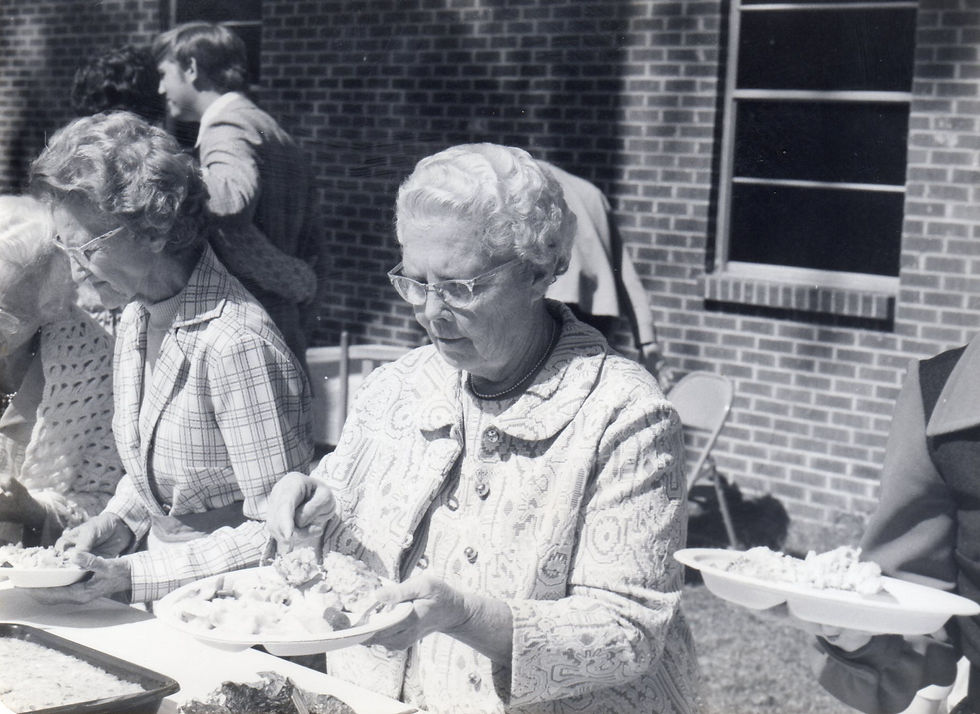Homecoming & Dinner on the Ground - Eastabuchie Baptist Church
- Tracie Salinas
- Jan 11, 2016
- 4 min read
It's hard to imagine a more southern event than dinner on the ground, when family and friends get together over truck loads of food and stuff themselves silly. Name a traditional southern dish, and you are likely to find it - maybe even 2-3 variations. Fried chicken, ham, potato salad, pecan pie, congealed salads, green beans, jugs of sweet tea - all were on the table, and the ladies who prepared them waiting impatiently for praise. Food is love in the south after all, and dinner on the ground provides an opportunity to shower love on others by bringing bowls and platters bursting with taste ... and to compete with other ladies over the particulars of a family recipe.
Recipes are treasures in southern families, so it's only natural that sharing a dish made from a decades old recipe would be a gesture of love. It's a moment of sharing something of a secret, a gift of sorts.
The pictures shown here are from homecoming dinner at Eastabuchie Baptist Church, October 19, 1975. Since one of my goals is to help others in their genealogy work, names are provided where I have them.

In the photo, pastor Thomas Kirkwood Ford can be seen in a suit on the left and other family members are in this shot. Note the towering pine trees in the background. Eastabuchie had been a central location for the timber industry for some time, but while pines may provide good timber, they don't always provide good shade.
Eastabuchie Church is designed similarly to many other churches built in the same era - a red brick rectangle with front doors to the vestibule and side doors into the fellowship hall areas near the back. While some churches had a separate covered area outside that housed picnic tables, Eastabuchie had a side door opened out onto the lawn, which had ample space for a long row of serving tables.
Dinners were held each year after Sunday service for Homecoming in the fall. In the South, church homecomings were often used to commemorate the anniversary of the founding of a church and drew members and their families togther to eat, sing, and visit with one another. Members who had moved away returned to enjoy dinner with their kin and with family friends. The tradition seems to emerge from roots in Scotland during Coventing meetings and field preachings, and it provides an opportunity to demonstrate what scholars refer to as religious familism. The sacredness of the church and family are integrated as a way to reaffirm the importance of kin in times of increasing social and economic mobility [1].

The side door of the fellowship hall is seen here to the far left, and the length of the serving tables can be better appreciated. They extend along the entire length of the church building itself.
In this picture, a number of folks who were central to the Eastabuchie church family are seen, incuding Juanita McLemore (lower right in glasses).

In the photo to the right are Mrs. Eunice Parker and Mrs. Alma Kelley.
Homecomings also commemorate founders with events and activities themed around a particular time period. In 1983, the church requested that guests dress in period clothes from the 1800s for Homecoming, and in good humor a number did. In the pictures below, you can see that the tables still stretch the length of the building, and there is still no shortage of food.

In the picture to the left, a number of folks in period clothes are seen as the choir presents the music of the service. As was typical in this sanctuary design, the Church Covenant is posted to one side with the baptistry and cross holding center position in the front. In this picture are a number of familiar faces, including former pastor Kirk Ford, Sr. (back row in tie to left of baptistry), Phyllis Burch (front row of choir, second from right), Gary Ford (back row, first from right). Irma Ford, wife of Kirk Ford, Sr. is seen on the right sitting in a corner of a pew.

In the photo at right, John Rounsaville is in the bow tie to the left.


To the left are Brother Oscar Petty and wife Merle (the two on the right), close behind is Brother Joe Royalty, another minister at Eastabuchie. In the forefront is Morris Tipton.
In the photo to the right, Irene Boudreaux and Ruth Baker (on the left) and other ladies are carefully arranging cakes on the dessert area while others are servivng food. To the right Juanita Mclemore (far right walking towards camera) and daughter Debbie McLemore Pitts (walking away) can also be seen.
Eastabuchie Baptist Church still opens its doors on Sundays to a small but sincere congregation. Dinners are more frequently in the Fellowship Hall now but are nonetheless prepared and served with as much care as when droves of families came to eat. In upcoming posts, I'll be including more from families that have been a part of Eastabuchie for those who do genealogy and a number of additional photographs of activities for those engaged in Jones/Forrest County histories.
[1] Seville, G.K. (2005) "Homecomings." Encyclopedia of Religion in the South. Mercer University Press.
Note: All photos above are credited to Pittman King, a long time member of Eastabuchie Baptist Church.

Comments